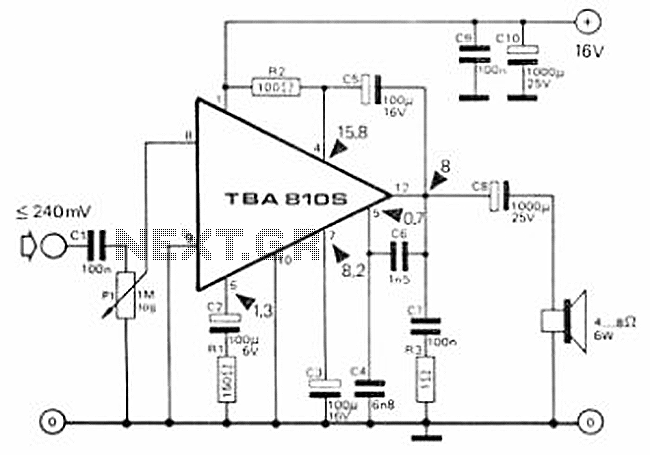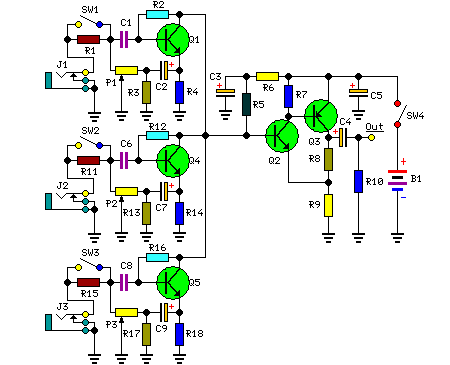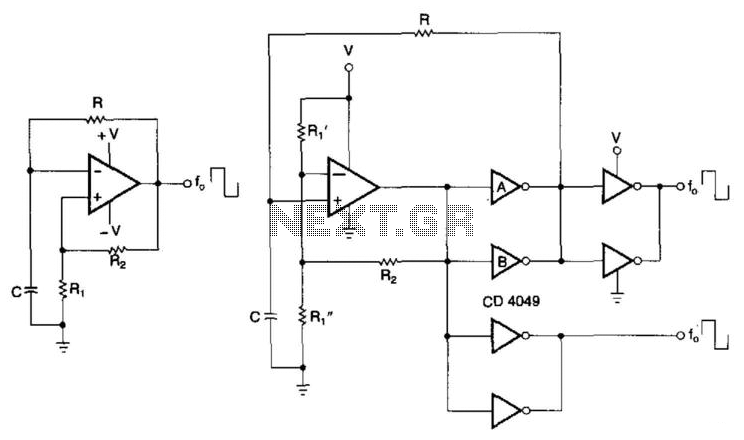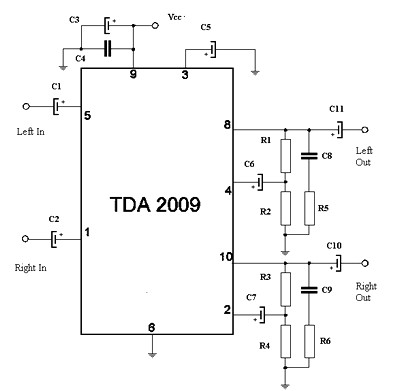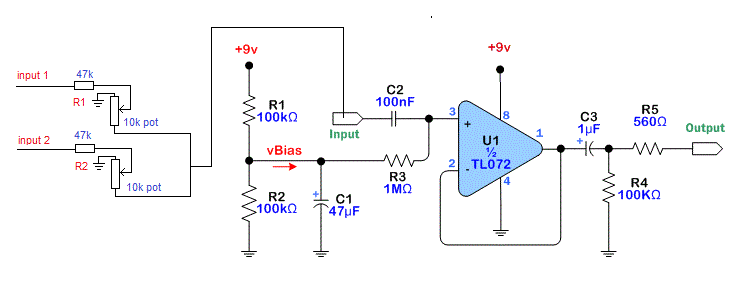
Audio oscillator
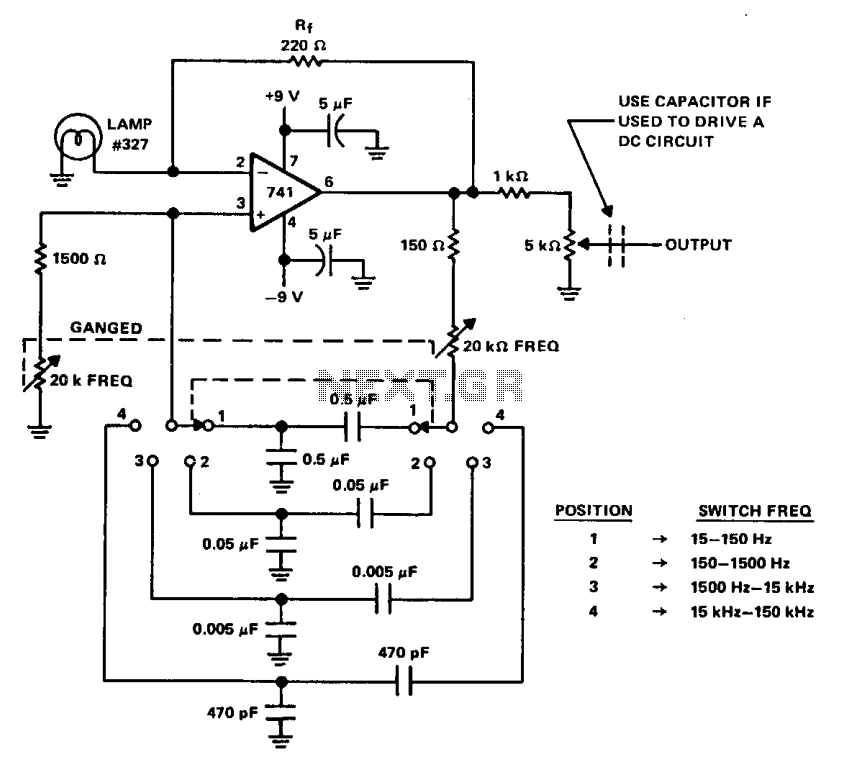
A Wien bridge oscillator generates sine waves with a very low distortion level. It produces zero phase shift at a single frequency (f = Vx t RC), which is the oscillation frequency. Stable oscillation can only occur if the loop gain remains at unity at this frequency. The circuit achieves this control by utilizing the positive temperature coefficient of a small lamp to regulate gain (Rf/RLamp) as the oscillator attempts to adjust its output. The oscillator features four frequency bands that cover approximately 15 Hz to 150 kHz. The frequency is continuously adjustable within each range using ganged 20 k ohm potentiometers. The oscillator consumes about 4.0 mA from the 9-V batteries, with an output voltage ranging from 4 to 5 V when connected to a 10 k ohm load. The feedback resistor (Rf) is set approximately 5% below the clipping point. The center arm of the 5 k ohm output potentiometer serves as the output terminal. To couple the oscillator to a DC circuit, a capacitor should be placed in series with the output lead.
The Wien bridge oscillator is a precision waveform generator widely used in audio and signal processing applications. Its design is based on a bridge configuration that employs resistive and capacitive components to establish a frequency-dependent condition for oscillation. The key to its operation lies in maintaining a balance between the resistive and capacitive elements to achieve a specific phase shift that is essential for sustained oscillation.
The oscillator operates with a feedback mechanism that adjusts the gain dynamically. The use of a small lamp, which has a positive temperature coefficient, allows for self-regulation of the gain. As the output amplitude increases, the temperature of the lamp rises, leading to an increase in its resistance. This, in turn, reduces the gain, preventing distortion and ensuring that the loop gain remains at unity at the desired oscillation frequency.
The four frequency bands enable a wide range of applications, from low-frequency signal generation to high-frequency test signals. The ganged 20 k ohm potentiometers provide fine control over the frequency settings, allowing for smooth transitions across the frequency range. The current draw of 4.0 mA from the 9-V power supply indicates efficient operation, making it suitable for battery-powered applications.
The output characteristics of the oscillator are designed to deliver a stable sine wave with an amplitude of 4 to 5 V under a 10 k ohm load, making it compatible with various electronic circuits. The feedback resistor (Rf) is crucial in determining the clipping point, and setting it slightly below this threshold ensures that the output waveform remains undistorted.
For applications that require interfacing with DC circuits, the inclusion of a coupling capacitor is essential. This capacitor blocks any DC offset present in the output, allowing only the AC component of the signal to pass through, thus protecting downstream components from potential damage caused by DC levels.
Overall, the Wien bridge oscillator is a versatile and reliable circuit for generating low-distortion sine waves across a broad frequency spectrum, with features that enhance its usability in various electronic applications.A Wien bridge oscillator produces sine waves with very low distortion level. The Wien bridge oscillator produces zero phase shift at only one frequency (f = Vx t RC) which will be the oscillation frequency. Stable oscillation can occur only if the loop gain remains at unity at the oscillation frequency. The circuit achieves this control by using the positive temperature coefficient of a small lamp to regulate gain (Rf/RLAMp) as the oscillator attempts to vary its output.
The oscillator shown here has four frequency bands covering about 15 Hz to 150 kHz. The frequency is continuously variable within each frequency range with ganged 20 k ohm potentiometers. The oscillator draws only about 4.0 mA from the 9-V batteries. Its output is from 4 to 5 V with a 10 k ohm load and the Rf (feedback resistor) is set at about 5% below the point of clipping.
As shown, the center arm of the 5 k ohm output potentiometer is the output terminal. To couple the oscillator to a dc type circuit, a capacitor should be inserted in series with the output lead.
The Wien bridge oscillator is a precision waveform generator widely used in audio and signal processing applications. Its design is based on a bridge configuration that employs resistive and capacitive components to establish a frequency-dependent condition for oscillation. The key to its operation lies in maintaining a balance between the resistive and capacitive elements to achieve a specific phase shift that is essential for sustained oscillation.
The oscillator operates with a feedback mechanism that adjusts the gain dynamically. The use of a small lamp, which has a positive temperature coefficient, allows for self-regulation of the gain. As the output amplitude increases, the temperature of the lamp rises, leading to an increase in its resistance. This, in turn, reduces the gain, preventing distortion and ensuring that the loop gain remains at unity at the desired oscillation frequency.
The four frequency bands enable a wide range of applications, from low-frequency signal generation to high-frequency test signals. The ganged 20 k ohm potentiometers provide fine control over the frequency settings, allowing for smooth transitions across the frequency range. The current draw of 4.0 mA from the 9-V power supply indicates efficient operation, making it suitable for battery-powered applications.
The output characteristics of the oscillator are designed to deliver a stable sine wave with an amplitude of 4 to 5 V under a 10 k ohm load, making it compatible with various electronic circuits. The feedback resistor (Rf) is crucial in determining the clipping point, and setting it slightly below this threshold ensures that the output waveform remains undistorted.
For applications that require interfacing with DC circuits, the inclusion of a coupling capacitor is essential. This capacitor blocks any DC offset present in the output, allowing only the AC component of the signal to pass through, thus protecting downstream components from potential damage caused by DC levels.
Overall, the Wien bridge oscillator is a versatile and reliable circuit for generating low-distortion sine waves across a broad frequency spectrum, with features that enhance its usability in various electronic applications.A Wien bridge oscillator produces sine waves with very low distortion level. The Wien bridge oscillator produces zero phase shift at only one frequency (f = Vx t RC) which will be the oscillation frequency. Stable oscillation can occur only if the loop gain remains at unity at the oscillation frequency. The circuit achieves this control by using the positive temperature coefficient of a small lamp to regulate gain (Rf/RLAMp) as the oscillator attempts to vary its output.
The oscillator shown here has four frequency bands covering about 15 Hz to 150 kHz. The frequency is continuously variable within each frequency range with ganged 20 k ohm potentiometers. The oscillator draws only about 4.0 mA from the 9-V batteries. Its output is from 4 to 5 V with a 10 k ohm load and the Rf (feedback resistor) is set at about 5% below the point of clipping.
As shown, the center arm of the 5 k ohm output potentiometer is the output terminal. To couple the oscillator to a dc type circuit, a capacitor should be inserted in series with the output lead.
